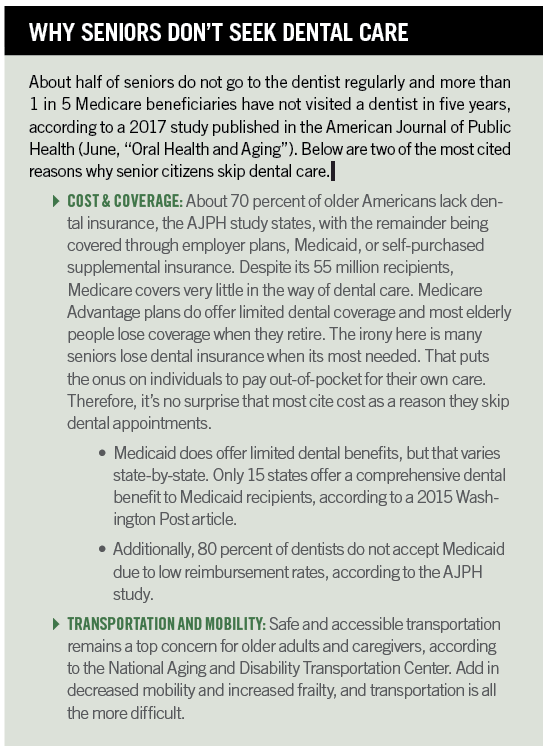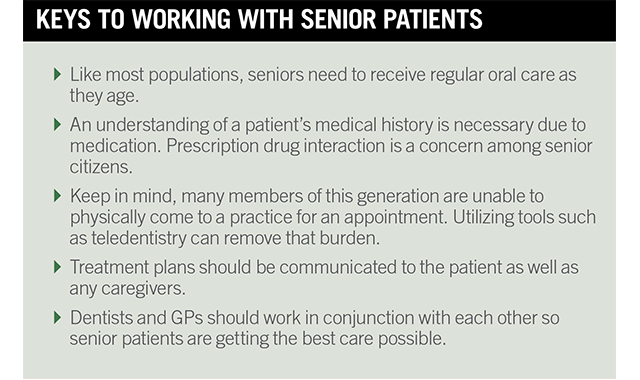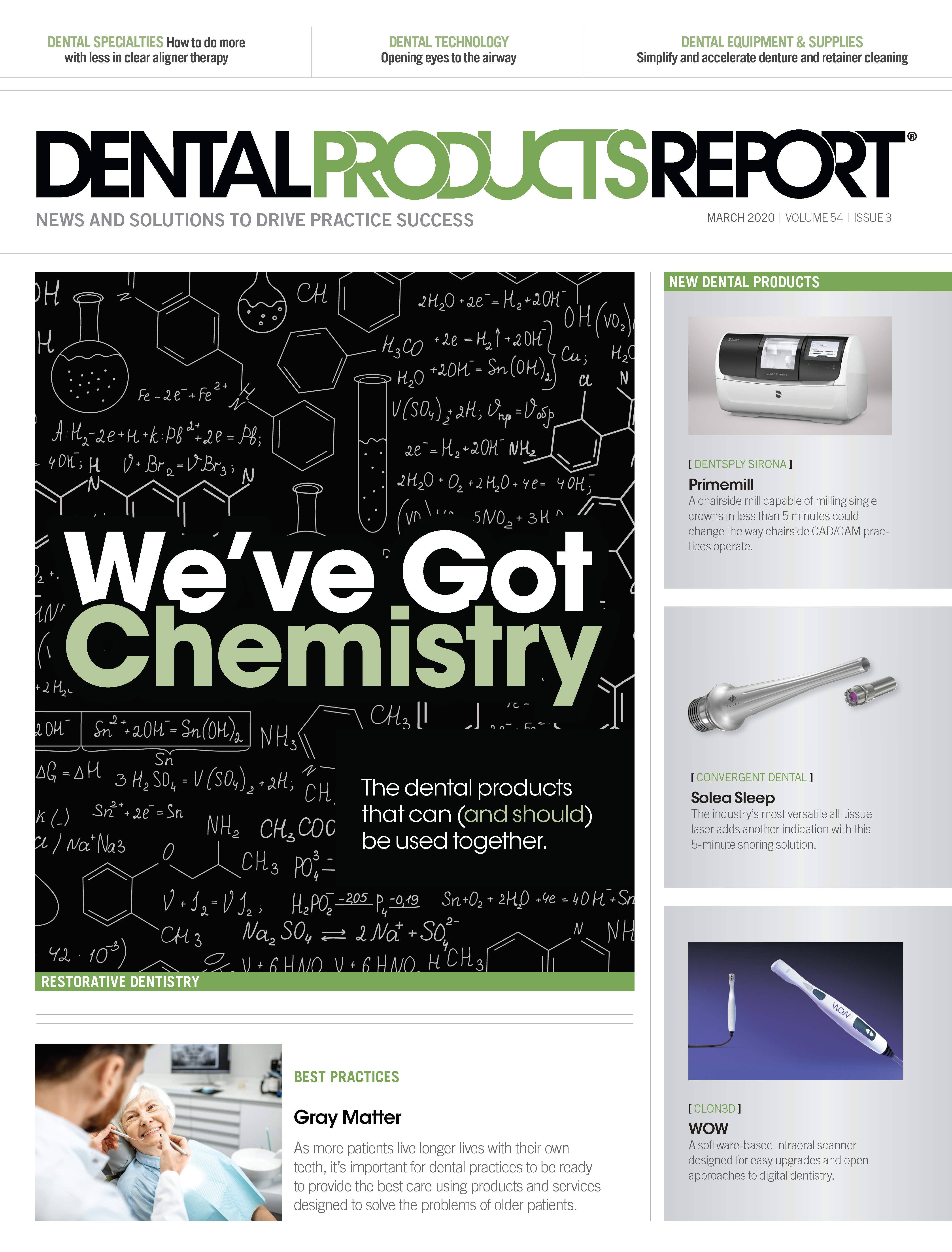Gray Matters: Dental care in an aging population
The elderly populace has its own individual needs when it comes to oral health.

While each patient is unique and has his or her own specific care needs, some patient demographics have their own group-wide demands. Not unlike pediatric dentistry, older patients require their own forms of care-from specific types of materials and equipment to the ways in which they are treated, not to mention their overall access to care.
Population needs
While loss of teeth increases with age and varies by race and ethnicity, nearly 19 percent of seniors 65 and up no longer have natural teeth, according to a 2017 study published in the American Journal of Public Health (June, “Oral Health and Aging”).
Tooth loss has multiple impacts on health and well-being. Seniors who have lost all or most of their natural teeth avoid eating fresh fruits and vegetables; a reliance on soft foods results in a decline in nutrition.
Additionally, 53 percent of seniors have moderate or severe periodontal disease, with evidence increasingly pointing at an association of periodontal disease with chronic conditions such as diabetes, heart disease, and stroke, the AJPH study states.
Part of the solution is regular, consistent oral care.
“There are a few things that are very important for older patients,” says Dr. Quinn Dufurrena, DDS, chief dental officer at United Concordia Dental. “Number one is that they need to be receiving regular oral care, because as they get older and their gums recede, it creates other problems, like root caries.”
Knowing the patient’s dental and medical record is necessary, and one detail that tends to suffer is having an accurate record of the patient’s medication. Some medications commonly cause dry mouth, while still others could pose interaction complications.
“A lot of times, patients forget what medications they’re on,” Dr. Dufurrena says. “And especially older individuals are sometimes on quite a few medications. I always ask my patients to bring a list of medications with them, because if they get to the office and they start writing them down, a lot of times they will forget, or, in some instances, they just don’t think that it’s important. But they don’t understand the ramifications of a lot of the medications that they take.”
53 percent of seniors have moderate or severe periodontal disease, with evidence increasingly pointing at an association of periodontal disease with chronic conditions.
To that end, simply having insurance coverage and access to a dentist is critical for seniors, especially because Medicare doesn’t cover most dental care, Dr. Dufurrena says.
“It is important to understand that the older population may not have employer-sponsored dental plans, and traditional Medicare doesn’t really cover dental,” Dr. Dufurrena says. “United Concordia Dental offers coverage under Medicare Advantage plans offered under many of our Blue partnership arrangements across the country. It’s important that this older population maintain coverage if they can.”
Continue reading on the next page...
Teledentistry
For some senior patients, physically getting to the office is extremely difficult. Under these circumstances, it’s helpful for dental professionals to visit to them instead. In such cases, a hygienist equipped with teledentistry gear can be dispatched so the patient doesn’t have to go to the office, but the dentist can still see what’s going on. MouthWatch’s TeleDent software platform helps coordinate those connections.
“It could be as simple a set up as an intraoral camera, which is very affordable-that we sell for $299-and then that gets plugged into a computer with a browser, and that’s all you need for someone, such as a nurse practitioner in a nursing home, to collect the visual data that facilitates a dentist creating a treatment plan,” says Brant Herman, CEO of MouthWatch. “It could be just a computer and intraoral camera, or it could be as robust as a full portable preventive or restorative care unit that a provider brings on site where they’re doing restorations, taking impressions for dentures or the original needs being identified via teledentistry. Even referrals can take place with this data.”

This means that hard-to-serve patients receive the care they need, and MouthWatch’s goal is to deliver a new method of care in the most convenient way possible, Herman adds.
“Our goal is connecting patients to dentists and dental care providers in the most convenient and efficient way possible,” Herman says. “We see teams of providers being able to deliver new models of care-a hygienist going into a nursing home or an independent living facility or a senior living community, providing preventive care, keeping the most expensive part of dentistry-the dentist-in a more efficient role where they’re building treatment plans, providing evaluations, and connecting patients to care. But, they’re doing that without having to travel and be on-site.”
Remote workflows
If a concern is identified, the dentist can jump onto the video feed and take a closer look. And just like in a traditional brick-and-mortar practice, the dentist conducts an evaluation of areas of concern, then makes a recommendation for treatment, and the patient is scheduled to come back for another appointment, Herman explains.
“All of that happens, except the dentist’s evaluation is happening virtually. If there is an offsite preventive program and there’s a need for treatment that’s recognized, the hygienist isn’t diagnosing, but they are identifying the areas of concern. The dentist is creating a treatment plan, and whether a mobile dentist goes out to the senior or transportation is arranged, and the senior comes into the brick-and-mortar practice, that’s what we’re able to provide.”
Similar to pediatric patients, a guardian may need to be involved when it comes to care for senior patients. In these cases, teledentistry allows for the easy sharing of information with caregivers.
“Sometimes, the same things that a kid needs are the things that a senior in a nursing home would need,” Herman says. “We can allow communication of treatment plans with images, with procedure codes, with clinical notes, so that a dentist who’s offsite at their home office builds a treatment plan. They include pictures of issues that are identified, cost estimates of what services they recommend. That treatment plan can now be shared.
"Our goal is connecting patients to dentists and dental care providers in the most convenient and efficient way possible.”
– Brant Herman, CEO of Mouthwatch
“If we’re in a school setting, it might go to the mom or the dad. In a senior setting, it goes to the power of attorney or the resident’s adult child. So, we’re sharing the information that’s needed for the elderly parent in the nursing home directly to the person who has to pay for the services.
“Now, the dentist and the adult child can have a video conference, communicate and say, ‘Look, can you explain this a little bit more? I’m not sure why mom needs two extractions and then a partial denture,’” he continues. “With a live video conference, the dentist can explain everything to the family member, get sign-off, and then go provide services to the senior.”
Continue reading on the next page...
End-to-end care
The dental and medical worlds tend to live in two disparate silos. That is, the two disciplines don’t often come together. However, there is more and more evidence that the two should be more complementary of each other.
“We have participated in a lot of research about the association between periodontal disease and systemic diseases like diabetes and heart disease,” Dr. Dufurrena says. “A lot of older patients don’t understand that association, and rightfully so. But, it’s very important for the dentists to understand this association.”
An easy way to achieve that goal is by simply asking questions and really listen to what patients have to say, Dr. Dufurrena says. Being aware of the interactions of prescription medication is paramount, he adds.
“In the short term, it’s very important that dentists ask their patients about their medications and really listen,” Dr. Dufurrena says. “A lot of times, a patient has a whole list of medicines that they’re on, and a lot of times it’s easier for the older patients to bring in a list. The dentist has to be very cognizant of the interactions of those medications.
“In the long-term,” he continues, “we should integrate medical and dental practice software, so the dentists have direct access to the medications a patient is taking. I think that would be a big help, but we’re a ways from that.”
Going deeper, it requires coordination between the dentist and medical doctor. Technologies like TeleDent can help with that communication, Herman observes.
“It helps improve the communication and collaboration between all of the touch points a patient might have in their healthcare journey,” he says. “Maybe that looks like a patient who is seeing an oncologist and needs periodontal treatment prior to chemotherapy. We want to connect that oncology office to a dental office so that they can have a visual evaluation. Maybe it’s an urgent care facility or an emergency room where, if you don’t have the dental services provided, you can efficiently connect that patient to the proper care services. We have a platform that allows that. They do it through real-time video conferencing, real-time data exchange. Also in teledentistry, we have what’s called an asynchronous – or store-and-forward – system, where information gets collected at one site, uploaded to the cloud, and because dentists are busy, they’re not on demand, but as soon as they have a few minutes to quickly look, they can log in, review all the clinical data, and build a treatment plan based on that.”
Generational concerns

Baby Boomers have always had an outsized presence compared with other generations, according to the Pew Research Center. This generation peaked at 78.8 million in 1999 and have remained the largest living adult generation. They hit retirement age in 2011 and their bubble will keep rising. In addition to their parents’ needs, this generation brings its own with them, as well.
“I read recently in the Journal of the American Dental Association that complete tooth loss in adults age 65 to 74 has decreased by more than 75 percent over the past decade,” Dr. Dufurrena says. “This older population is keeping their teeth longer, which creates other issues. That’s great, but it means they are prone to other problems, like caries.”
But, no matter which generation is being discussed, Dr. Dufurrena observes that going in to see a dentist is a critical concern.
“It’s important to have insurance, and that’s why United Concordia provides coverage through Medicare Advantage,” Dr. Dufurrena says. “The main thing is to keep older individuals going to the dentist.”
Older patients, certainly, have their own, specific needs. With the combined work of dentists and general practitioners, as well as tools such as teledentistry, there can be mechanisms in place that help seniors get the care they need.
Associate Editor Kristin Hohman contributed to this article.
